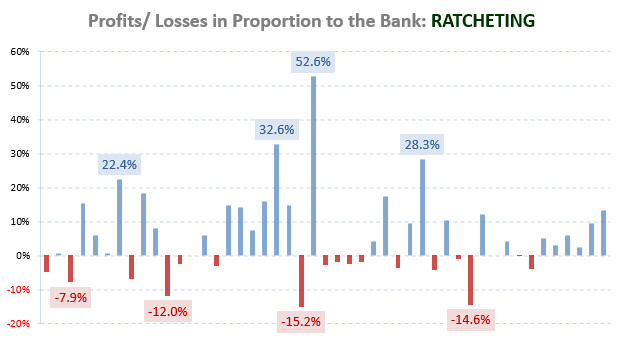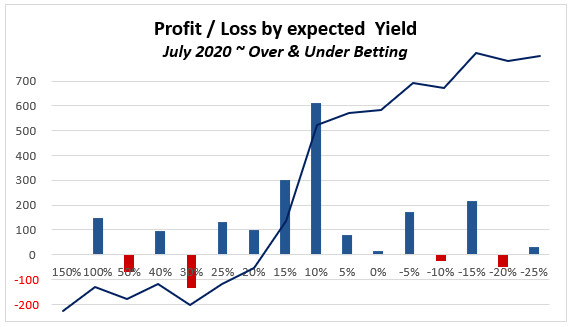
If you have investigated staking plans to any degree then you will certainly have already heard of various different strategies such as Martingale, D’alembert, Fibonacci, Parlay, Kelly, Square Root, Labouchere, Retirement, etc.
You should not be dazzled by their mechanisms because none of these staking plans will work at all if your betting system has no mathematical ‘edge’. Indeed, with a blunt selection strategy the only mark even a highly sophisticated staking plan will make on your betting experience is how long it will be before your bank is lost.
 Image: Ninell (Shutterstock)
Image: Ninell (Shutterstock)In this article, I will not be analysing the myriad staking plans as there is plenty of information already on the Net. For example, just key in the words “staking plan”, or any of above names into the search engine of your choice.
I have said many times before on this blog that there is no way to make money in the long run from betting without having an edge over the market. Therefore, honestly, if you have arrived on this blog and you are reading this article because you hope to find a staking plan to turn your luck, then please forget it. First of all you need to find a selection system that works for you and which contains that magical ‘edge’!
If you have found your betting system then there is no need for any complicated staking plan, simply plump for a level risk/stake. All other staking plans contain one or another problem and please rest assured that there is definitely not a single staking plan in existence which makes a failing betting system work.
It’s only your knowledge of the market which will determine your success, and this means a good understanding of probabilities and betting odds and the knowledge of how to use them to your advantage.
Level Stake/Risk Staking Plan
The benchmark for any betting system is the level risk staking plan.
This means risking a fixed unit per bet. A selection system that does not produce a profit to level risk simply does not have a positive edge, and is doomed to lose in the long run.
There are two varieties of this staking plan:
(1) The simple version: Level Stake
This means risking the same amount of money with each and every bet. This applies to back as well as to lay bets.
Back bets are pretty easy. You risk, for example, 10 units per bet and it doesn’t matter how low or high the odds are.
Lay bets require some calculation as you need to calculate the stake for each bet individually in order to risk the same amount every time (e.g. 10 units) to minimise losses.
(2) The advanced version: Fixed Win/Risk Staking Plan (equal win, equal risk)
This strategy takes into account the probabilities (odds), meaning that there is a higher stake (i.e. risk) for bets with a higher chance of winning, and a proportionately reduced stake the lower the chance of winning a bet is (i.e. providing money for more attempts to get a ‘hit’ at higher odds).
This is an even more conservative approach than the “level stake” but in the end the outcome is more or less the same for most betting systems. The deviations are lower meaning that losing streaks (troughs) don’t reduce the bank as much, and winning streaks (peaks) are also levelled to some degree. The result is a less jagged performance with fewer heavy swings of misfortune and fortune. Evening-out the peaks and troughs makes the prediction of future performance also a little easier.
In essence fixed win/risk means the stakes employed depend upon the odds, but the risk and attainable profit remain constant. Wagers are always limited, for example to a maximum risk per bet of 10 units, or to a maximum win of 10 units.
Fixed Win/Risk Strategy Examples:
- Back Bets at odds of up to 2.0: Example 1.69; the stake (risk) is 10 units; if the bet wins, the winnings are 6.90 units; if bet loses, then 10 units are lost.
- Lay Bets at odds of up to 2.0: Example 1.69; winnings are capped at 10 units; if bet wins, the winnings are 10 units; if bet loses, the loss is 6.90 units.
- Back Bets at odds over 2.0: Example 3.5; winnings are capped at 10 units; if bet wins, the winnings are 10 units; if bet loses, the loss is 4 units.
- Lay Bets at odds over 2.0: Example 3.5; loss is capped at 10 units; if bet wins, winnings are 4 units; if bet loses, then 10 units are lost.
You may be surprised to hear but that’s it! There is absolutely no need to bother with any other staking plans.
If your system does not work either with “level stake” and/or “fixed win/risk” then you have a problem and seriously need to reconsider your strategy as being potentially flawed.
Please note that I have written and/or as it really doesn’t matter if you use “level stake” or “fixed win/risk”. Both staking plans are mathematically sound, and are more or less the same. Both staking plans will produce a benchmark for a betting system to test if it is working or not.
If you have found a betting system which works with “level stake” and/or “fixed win/risk” then the only thing you need to know in addition is which percentage of your bank to risk on an individual bet.
For this you need to calculate the Expected Losing Sequence meaning the maximum number of bets in a row which are likely to go wrong (lose), and from this, you will then be able to calculate the percentage of your bank to be risked per bet to ensure you never go bankrupt…
…But this is a topic for another day.
One more thing though: There are actually many people who have a good selection system because they have in-depth knowledge of certain teams and have developed a good gut feeling for probabilities (even if they are not necessarily able to mathematically explain their choices and calculate odds).
However, because these people are oblivious to the necessity for a controlled staking plan, they often do not stick to a set of rules, e.g. same risk per bet, and therefore they lose.
If you happen to be one of these bettors, please re-read this article and I urge you to start applying the same risk on all your bets. Your immediate reward for just a little discipline will be a gradually growing betting bank.
Be happy with “growing gradually”; don’t be greedy – and then you will be successful!
Of course, it certainly also helps if you have an idea how odds are calculated…






Thank you very much. On Tuesday night I was lucky as I’ve hit 11 out of 18 games in lower English leagues which netted me decent profit but I know not every night will be like that. I think I will limit myself to 2.5% of bank when games are being played at same time and continue with 5% when games are being played one after another. I’m confident in that 5% as long as games are not played at same time because I only bet on teams which had above 60% hit rate on “2-3 goals” market and that earned me more than decent profit in last month. My hit rate so far was some 55% over 400 games so that is hit rate I am expecting.
I have read almost all articles on this site including those you proposed and your “winning losing streaks” spreadsheet suggests investing 11% of bankroll for expected hit-rate of 55% but that’s still too much for me, I think 5% is much safer. But its different when games are being played at same time because one anomalous set of games with very low hit-rate can make me almost bankrupt. I have to implement more cautious approach.
Thanks for your answer!
Hello dear Soccerwidow.
I have one simple question regarding betting according to percentage of betting bank. For last one month I was betting on goal range 2-3 goals quite successfully and I managed to increase my betting bank for 410%. I bet 5% of my bank per game.
However, I have problem when many games are played at same time like in lower English leagues tonight or on Saturdays. Maybe I made mistake but tonight I put a bet on 18 games, each game I spent 5% of my bank so now only 10% of funds remained in my bank. I hope that I will hit at least 50% of games to be somewhere near zero or above. In previous situations I always had profit or small loses when betting on many games played at same time so I continued to risk.
My question is – is this too risky? Should my stakes when there are many games at same time be lower, eg. 2.5% or even 1%? Because if one day or night goes wrong I could lose everything I have earned in long time. What is your suggestion, how big stakes should I put when there are 15 or 20 games at same time without endangering betting bank too much?
Thanks in advance and best regards,
Stefan
Hi Stefan, the size of your stakes really depends on the hit rate you are expecting. Here are two articles which may help you:
The Science of Calculating Winning and Losing Streaks
How to Calculate Losing Streaks & Optimal Bankroll
What may also be of great help to you is my course: Fundamentals of Sports Betting A whole chapter of the course is dedicated to Risk Control. There you’ll learn important financial measurements such as Yield, ROI and profitability as well as how to calculate the necessary size of a starting bank and stake sizes.
Good luck!
Hi there.
I really appreciate your website, and i’ve found a lot of useful information so far. Though, i have a question about the fixed win strategy, and i would be happy if you could elaborate a bit.
I’ve seen other people on forums suggest it as well, but i can’t seem to figure out why you want to cap the risk when betting on odds under 2.
Obviously it’s though luck to lose a huge bet on a odds 1.3, but isn’t it decreasing the profit in the long run if you keep on capping it? Eventually those low odds are going to catch up.
Thanks!
Hi Dennis,
Betting succes is all about probabilities and getting the right price for a bet.
Low odds (to be correct… any odds) will unquestionably catch up with the bettor, if he/she is betting consistently under value. Meaning that he/she is accepting/taking prices which present a higher probability than the true expectation and final observations.
Here are a few links to articles which may help you to understand the connection between probabilities, hit rates and staking planing better:
Value Betting – Popular Misconceptions & Common Myths
Probability, Expectation, Hit Rate, Value, Mathematical Advantage: Explained
Psychology of Gambling and the Importance of a Staking Plan
Hope this helps…
I will also take your question and think about how to address it via articles, tutorials, and maybe even courses and Excel calculators. This is certainly an issue which comes up quite a lot.
Hello soccerwidow.recently i bought your value calculation sistem for league matches and im kinda satisfied by it , but i dont have a stacking so i keep loosing because i dont know how many units should i invest in every bet.what stacking plan do you use?i seen some of your screenshots with bets , but i see that you are not using the level stacking plan.so can you please tell me the secret of your stacking plan?Please help me !
Hi Sergiu,
there is no secret. It’s either simply level staking or fixed win/risk. It is not the staking plan which makes a selection system successful, it’s the selections.
Nice work!
Have to say though, that systems are very difficult to get right, because you basically need the one thing gamblers don’t normally possess-control.
This is how you become a pro gambler, by having some control.
I work in Soccer Predictions and I’ve been successful for some time but not without it’s ups and downs.
You could also try using your calculated winning percentage as a base (instead of fixed profit). According to my back testing, this method allows the bank to be more stable than fixed profit. Provided your calculated percentage is correct / have value.
I agree with you, by choosing right staking plan, you can save yourself from a big loss and there will be win-win. To me it’s also important to get betting tips from betting experts.
Great I look forward to the next article. And yes, I was only using 10% as an example to make the numbers simple. My usual stake is 3-5% and then varies around that until it is rebalanced.
Hi,
I am interested to know if you adjust your per bet % of capital constantly or periodically (or at all). For example, if your expected losing sequence allows for a fixed win/risk stake of %10 of your capital, and hence you stake $10 on a $100 bank, do you adjust this to $11 if you get to $110 and then each bet after? Or do you wait to you hit a certain threshold, say $150 bank and raise to $15 stake?
Yes, we adjust (ratchet). I’m actually right now in the process of writing an article on this topic.
%10 of your capital is huge! This would require a consistent 90% hit rate (strike rate/ probability of winning).
However, many people play at odds around 1.8 to 2.5. This means if consequently choosing value bets you are looking at probabilities somewhere between 45% & 60% which means that the maximum risk should be no more than 2.5 to 4% of your betting bank, depending on the probability cluster the bet is in.
Already looking forward to the upcoming Expected Losing Sequence article….